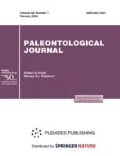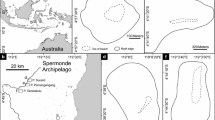Abstract—
An ultramicroscopic study of tubiphytes—tubular formations, composed of pelitomorphic calcite from the Lower Permian Tra-Tau reef (Cis-Urals)—was carried out. A multilayer structure of the walls was recognized. The inner layer is an ultrathin layer of acicular calcite crystals, which often has aragonite habit; the next layer is a relatively thick one represented by a dense pelitomorphic mass, which is often encrusted with the calcite crystals. Between the first and second layers are traces of mineralized biofilms, “lace” secretions of mineralized glycocalyx. It is assumed the inner layer is the tubiphyte wall and the pelitomorphic one is the result of biochemogenic carbonate precipitation as a consequence of ability of epiphytic bacterial activity, which colonized the walls of an original organism. A relatively high C/Ca ratio in the glycocalyx relics, its consequent decrease from the acicular wall towards the pelitomorphic one, and finally to the purely chemogenic crystalline formations of crustified rims is an indirect proof of such a formation mechanism of tubiphytes.




Similar content being viewed by others
REFERENCES
Flügel, E., Microfacies of Carbonate Rocks Analysis, Interpretation and Application, Berlin: Springer, 2004.
Gekker, R.F., Reef buildups and problems in geoecology, in Iskopaemye rify i metodiki ikh izucheniya (Fossil Reefs and Methods of Their Study), Sverdlovsk: RISO Ural. Fil. Akad. Nauk SSSR, 1968, pp. 18–26.
Immenhauser, A., Schoene, B.R., Hoffman, R., and Niedermayr, A., Mollusk and brachiopod skeletal hard parts: Itricate archives of their marine environment, Sedimentology, 2016, vol. 63, pp. 1–59.
Kuznetsov, V.G., Specifics of the lithogenesis different-facies carbonate deposits in the light of the teaching of L.V. Pustovalov concerning the stages of sedimentogenesis, in Problemy ekzogennogo i metamorfogennogo porodo- i rudoobrazovaniya (Problems of Exogenic and Metamorphogenic Ore Formation), Moscow: Nauka, 1985, pp. 60–72.
Lowenstam, H.A., Minerals, formed by organisms, Science, 1981, vol. 211, pp. 1126–1131.
Maslov, V.P., Iskopayemye izvestkovye vodorosli SSSR (Fossil Calcareous Algae of the USSR), Tr. Iinst. Geol. Nauk Akad. Nauk SSSR, vol. 160, Moscow: Akad. Nauk SSSR, 1956.
Rauzer-Chernousova, D.M. and Lipina, O.A., Facies of the Upper Carboniferous and Artinskian deposits of the Sterlitamak–Ishimbaevo Region of the Cis-Urals based on studying fusulinids, Foraminifery verkhnego devona Russkoy platformy (The Upper Devonian Foraminifers of the Russian Platform), Tr. Inst. Geol. Nauk Akad. Nauk SSSR, vol. 119, Ser. Geol., no. 43, Moscow:. Akad. Nauk SSSR, 1950.
Riding, R. and Guo, L., Affinity of tubiphytes, Palaeontology, 1992, vol. 35, pp. 37–49.
Sandberg, P.A., An oscilating trend in Phanerozoic nonskeletal carbonate mineralogy, Nature, 1983, vol. 305, pp. 19–22.
Sumner, D.Y. and Grotzinger, J.P., Late Archean aragonite precipitation: petrography, facies associations, and environmental significance, in Carbonate Sedimentation and Diagenesis in the Evolving Precambrian World, Grotzinger, J.P. and James, N.P., Eds., SEPM Spec. Publ., vol. 67, Tulsa: Soc. Sedimentary Geol., 2000, pp. 123–144.
Vieira, L.C., Nedelec, A., Fabre, S., Trindade, R.I.F., and de Almeida, R.P, Aragonite cristal fans in Neoproterozoic cap carbonates: a case study from Brazil and implications for the post-Snowball Earth coastal environment, J. Sedimentary Res., 2015, vol. 85, nos. 3–4, pp. 285–300.
Webb, G.E., Biologically induced carbonate precipitation in reefs through time, in The History and Sedimentology of Ancient Reef Systems, Stanley, G.D., Ed., N.Y.: Kluwer, 2001, pp. 159–203.
Author information
Authors and Affiliations
Corresponding author
Additional information
Translated by D. Voroshchuk
Rights and permissions
About this article
Cite this article
Kuznetsov, V.G., Zhegallo, E.A., Zhuravleva, L.M. et al. The Ultramicrostructure of Tubiphyte Walls. Paleontol. J. 54, 205–213 (2020). https://doi.org/10.1134/S0031030120020069
Received:
Revised:
Accepted:
Published:
Issue Date:
DOI: https://doi.org/10.1134/S0031030120020069




